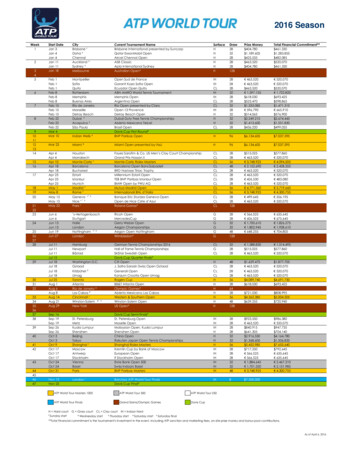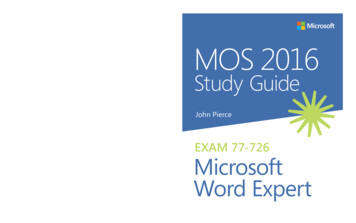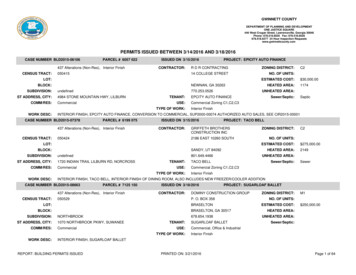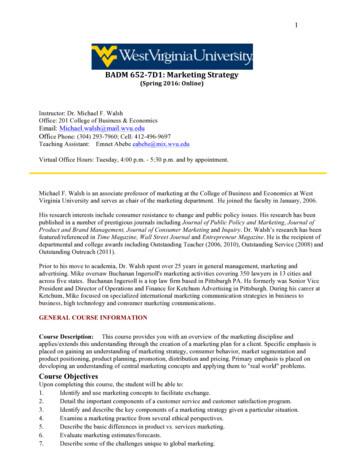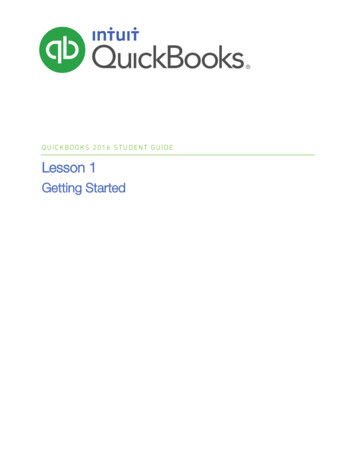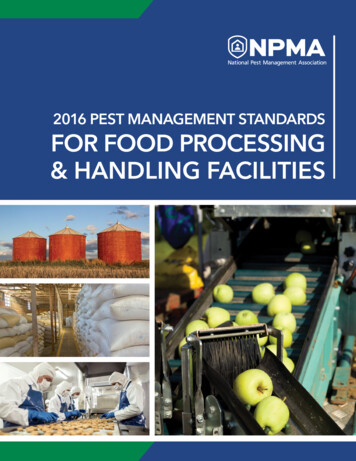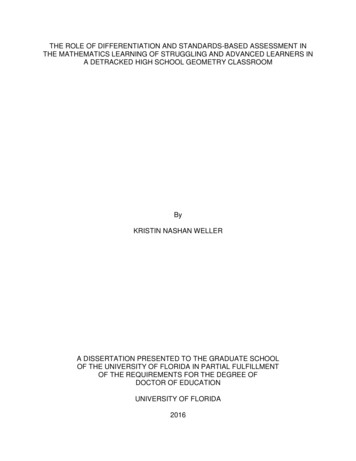
Transcription
THE ROLE OF DIFFERENTIATION AND STANDARDS-BASED ASSESSMENT INTHE MATHEMATICS LEARNING OF STRUGGLING AND ADVANCED LEARNERS INA DETRACKED HIGH SCHOOL GEOMETRY CLASSROOMByKRISTIN NASHAN WELLERA DISSERTATION PRESENTED TO THE GRADUATE SCHOOLOF THE UNIVERSITY OF FLORIDA IN PARTIAL FULFILLMENTOF THE REQUIREMENTS FOR THE DEGREE OFDOCTOR OF EDUCATIONUNIVERSITY OF FLORIDA2016
2016 Kristin Nashan Weller
To Trent, Briana, Patryk, Mom, and Dad
ACKNOWLEDGMENTSI would like to begin by thanking the members of my doctoral committee. I metDr. Nancy Dana when I took my first inquiry class in 2005, and I feel as though she hasbeen my personal cheerleader for learning, reflecting, and improving my own practiceever since. She is one of the most caring and kind individuals, professionally andpersonally – she always listened, provided support, guided me through countless drafts,and made me believe in myself. I consider her my mentor, colleague, and friend.Thank you so much. I would like to thank Dr. Tim Jacobbe for his encouragement anddirection in supporting students’ understanding of secondary mathematics. His quietand thought-provoking questions pushed me to dig deeper into finding ways to help allof my students succeed. I would also like to thank Dr. Kent Crippen and Dr. CynthiaGriffin for their interest in my research and their challenging questions during myqualifying exams.I am thankful for my students that I have taught over the past 25 years. Withoutthem, I would not have pushed myself to be a better teacher. They are the reason forwhat I do, whether they bring me great joy or occasional frustration. Thank you forhelping “Mama Weller” learn alongside you.Thank you to my friends, Mickey MacDonald and Melanie Harris. We are the“Three Musketeers,” and I could not have gotten through these years of hard workwithout our breakfasts, Sunday meetings in the Tank, or supportive text messagesreminding me that I could do it. I will remember our laughter and tears and know that Iwill always have two women who are my sisters. I love you both.I thank my mother, Ruthann Nashan. Mom, you’re always there to take up theslack, no matter what. Your love and encouragement have helped me so much – I4
could not have made it through these years without our daily morning phone calls, yourhelping me make sure the family did not starve, and being there whenever I needed youto be there. I hope that I can be like you when I grow up – you are the best mom ever.I would like to send thanks to my father, Robert Nashan, Sr. Even though youhave been gone for over 18 years, I can still hear you in my head, telling me that I cando this. You always said the same thing to me – “Do your best, that’s all I ask.” Irepeat those words to my own children, knowing that that is the best lesson I can teachthem. This degree is for you, Dad, because I promised you I would do it.I would like to thank my husband, Trent. You are my best friend, the person Ican talk to about anything, and the most wonderful husband and father in the world.Your ability to find humor and keep me from taking myself too seriously alleviated stressat just the right moments. Your steadfast encouragement is what let me perseverethrough the toughest parts of the process – you are my rock. I love you more than youwill ever know.Finally, thank you to my children, Briana and Patryk. You make me proud, and Icannot imagine what my life would be without your hugs and words of reassurance –“you can do this, Mom” are words that helped me through late nights and longweekends. I love you both.5
TABLE OF CONTENTSpageACKNOWLEDGMENTS . 4LIST OF TABLES . 10LIST OF FIGURES . 11ABSTRACT . 12CHAPTER1INTRODUCTION AND BACKGROUND . 14Introduction and Purpose Statement . 14Purpose and Research Questions . 20Methodology . 21Significance of the Study . 22Summary and Statement of Collaboration . 23Overview of Dissertation . 252REVIEW OF LITERATURE . 26Gaps in Educational Opportunity . 27The Opportunity Gap . 27The Expectations, Relationships, and Participation Gaps . 28Tracking . 33Birth of Tracking . 34Assumptions that Support Tracking . 35Problems Inherent with Tracking . 38Elimination of Tracking through Differentiation and Standards-BasedClassrooms. 45Best Practices in Schools that have Eliminated Tracking . 46Differentiated Instruction . 48Differentiating the Content . 49Differentiating the Process . 50Differentiating the Product . 51Standards-Based Grading . 53Summary and Conclusions . 553METHODOLOGY . 56Practitioner Research . 56Context for Study . 58Participants . 60Struggling Learners . 606
Advanced Learners . 62Data Collection . 64Data Analysis . 67Credibility and Trustworthiness of Study . 70Researcher Background, Biases, Values, and Experiences . 71Conclusion . 754PLANNING A DIFFERENTIATED AND STANDARDS-BASED MATHEMATICSUNIT: THE PYTHAGOREAN THEOREM . 76Chapter Overview . 76The Detracked Honors Geometry Classroom in a Developmental ResearchSchool. 77Identifying the State Standards and Learning Targets . 80Developing the Unit Summative Assessment . 81Planning the Unit’s Daily Schedule and Instructional Activities . 86Unit’s Daily Schedule . 86Developing the Unit Formative Assessments . 91Conclusion . 935IMPLEMENTING A DIFFERENTIATED AND STANDARDS-BASEDMATHEMATICS UNIT: THE PYTHAGOREAN THEOREM . 95Chapter Overview . 95Implementing the Pythagorean Theorem Unit Day 1: Monday, February 23,2015. 96Overview . 96Opening Activities . 96Class Instruction and Activities . 99Student Reflections . 103Implementing the Pythagorean Theorem Unit Day 2: Wednesday, February 25,2015. 106Overview . 106Opening Activities . 107Classroom Instruction and Activities . 111Implementing the Pythagorean Theorem Unit Day 3: Friday, February 27, 2015 . 122Overview . 122Opening Activities . 122Classroom Instruction and Activities . 126Student Reflections . 136Implementing the Pythagorean Theorem Unit Day 4: Monday, March 2, 2015 . 138Overview . 138Classroom Instruction and Activities . 139Student Reflections . 143Implementing the Pythagorean Theorem Unit Day 5: Wednesday, March 4,2015. 144Overview . 1447
Opening Activities . 144Classroom Instruction and Activities . 147Student Reflections . 150Summative Assessment: Friday, March 6, 2015 . 152Overview . 152Administration of the Summative Assessment . 153Results of Summative Assessment and Opportunities to Re-Assess. 154Student Reflections . 156Summative Re-Assessment: Friday, March 20, 2015 . 157Overview . 157Administration and Results of the Summative Re-Assessment . 157Student Reflections . 158Conclusion . 1596LEARNING FROM MY TEACHING OF A DIFFERENTIATED ANDSTANDARDS-BASED UNIT OF STUDY: THE PYTHAGOREAN THEOREM . 160Chapter Overview . 160How Differentiated Instruction and Standards-Based Assessment Supported theLearning of My Struggling and Advanced Learners . 161Using Homogeneous Grouping when Introducing New Content . 161Using Heterogeneous Grouping when Reviewing Content . 165Allowing for Both Teacher and Student Choice for Grouping . 167Why Differentiated Instruction and Standards-Based Assessment Supported theLearning of My Struggling and Advanced Learners . 170Framing Differentiation and Standards-
May 2016 Chair: Nancy Fichtman Dana Major: Curriculum and Instruction To gain insight into how using differentiated instruction and standards-based assessment supported my students’ learning in a detracked, honors geometry classroom, I employed the methodology of practitioner research to

